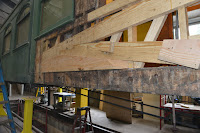 |
Pullman builder's photo, courtesy of the
California State Railroad Museum library. |
Parlor car 1799 is a Pullman Company product constructed almost entirely of wood, and completed in 1901. The car was built for extra fare (first class, similar to business class today) service on the Northern Pacific Railway's Lake Superior Limited serving between Minneapolis/St Paul and Duluth. Later, the car was transferred to Washington State where it operated on the North Coast Limited between Seattle and Spokane. The car was retired in 1940 and sold for use as a cottage on Whidbey Island. It was donated to the Northwest Railway Museum and moved to Snoqualmie in 2018.  |
The cottage era doors were removed earlier this year. |
During the cottage era when it resided on Whidbey Island, two entry doors were cut into the carbody in the center of the car, one on each side. The key objective of the rehabilitation and restoration is to return to the car to its period of significance when it operated on the Northern Pacific Railway. So the doorways had to be removed and the missing components in the truss restored.
 |
Floyd cuts a truss component to length for use on the 1799. |
Floyd V. took the lead on this part of the project and fabricated in kind replacement sections of compression truss from southern yellow pine. Next, the truss plank was replaced in kind using two large planks of Douglas fir. Then the inter truss blocking was replaced with Douglas fir planks, though they were originally yellow poplar heartwood, which is not currently available to the Museum. New sections were attached to old with lap slices, wood screws, and marine epoxy. A replacement window sash set will be fabricated and installed later; new exterior cladding will be applied soon.
 |
The cottage-era doorway is no more; a window
will be placed in the opening. |
Rehabilitation and restoration of parlor car 1799 is continuing inside the Northwest Railway Museum's Conservation and Restoration Workshop. Funding for this phase of the parlor car project has been provided by individual contributions, the Washington State Historical Society Heritage Capital program, the Washington Trust for Historic Preservation, and by the Nysether Family Foundation.Your support is welcome, and will be used to complete this major effort!. Please click here to be directed to the Museum's contribution page.
 |
New wood is seen in the compression
truss on parlor car 1799. |
 |
This 1909 cab builder's diagram illustrates the carbody structure in a modern wood car that is normally invisible to passengers. |






